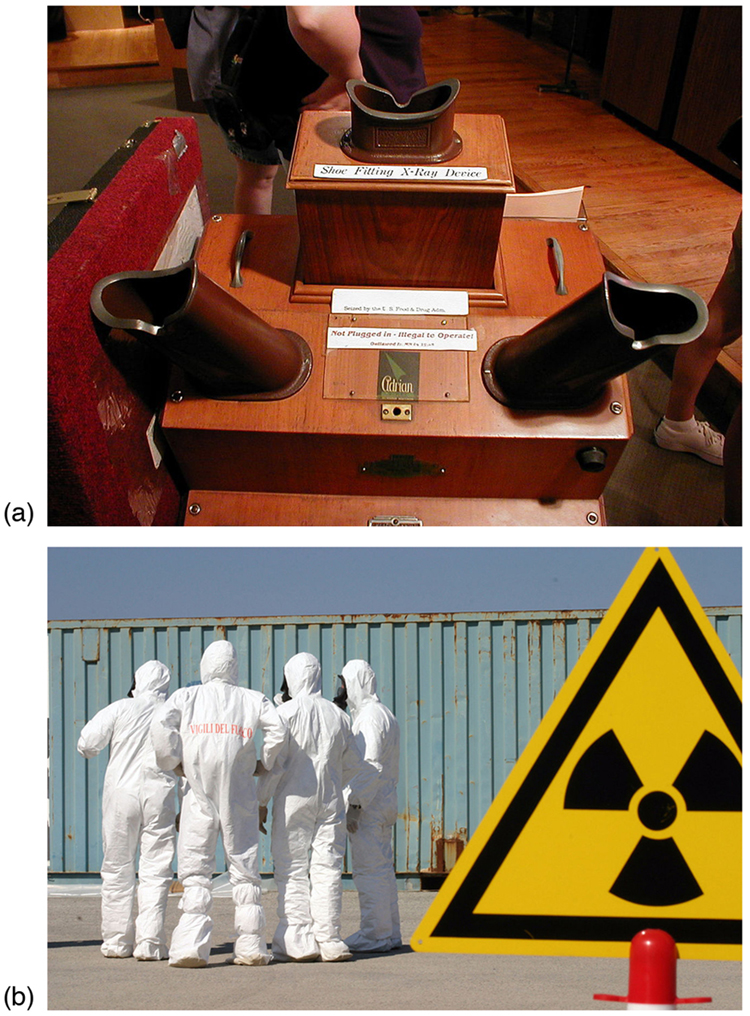| << Chapter < Page | Chapter >> Page > |
Strategy
Dose in rem is defined by and . The energy deposited is divided by the mass of tissue affected and then multiplied by the RBE. The latter two quantities are given, and so the main task in this example will be to find the energy deposited in one year. Since the activity of the source is given, we can calculate the number of decays, multiply by the energy per decay, and convert MeV to joules to get the total energy.
Solution
The activity decays/s. So, the number of decays per year is obtained by multiplying by the number of seconds in a year:
Thus, the ionizing energy deposited per year is
Dividing by the mass of the affected tissue gives
One Gray is 1.00 J/kg, and so the dose in Gy is
Now, the dose in Sv is
Discussion
First note that the dose is given to two digits, because the RBE is (at best) known only to two digits. By any standard, this yearly radiation dose is high and will have a devastating effect on the health of the worker. Worse yet, plutonium has a long radioactive half-life and is not readily eliminated by the body, and so it will remain in the lungs. Being an emitter makes the effects 10 to 20 times worse than the same ionization produced by s, rays, or x-rays. An activity of is created by only of (left as an end-of-chapter problem to verify), partly justifying claims that plutonium is the most toxic substance known. Its actual hazard depends on how likely it is to be spread out among a large population and then ingested. The Chernobyl disaster’s deadly legacy, for example, has nothing to do with the plutonium it put into the environment.
Medical doses of radiation are also limited. Diagnostic doses are generally low and have further lowered with improved techniques and faster films. With the possible exception of routine dental x-rays, radiation is used diagnostically only when needed so that the low risk is justified by the benefit of the diagnosis. Chest x-rays give the lowest doses—about 0.1 mSv to the tissue affected, with less than 5 percent scattering into tissues that are not directly imaged. Other x-ray procedures range upward to about 10 mSv in a CT scan, and about 5 mSv (0.5 rem) per dental x-ray, again both only affecting the tissue imaged. Medical images with radiopharmaceuticals give doses ranging from 1 to 5 mSv, usually localized. One exception is the thyroid scan using . Because of its relatively long half-life, it exposes the thyroid to about 0.75 Sv. The isotope is more difficult to produce, but its short half-life limits thyroid exposure to about 15 mSv.
Watch alpha particles escape from a polonium nucleus, causing radioactive alpha decay. See how random decay times relate to the half life.

Isotopes that emit radiation are relatively safe outside the body and exceptionally hazardous inside. Yet those that emit radiation are hazardous outside and inside. Explain why.
Why is radon more closely associated with inducing lung cancer than other types of cancer?
The RBE for low-energy s is 1.7, whereas that for higher-energy s is only 1. Explain why, considering how the range of radiation depends on its energy.
Which methods of radiation protection were used in the device shown in the first photo in [link] ? Which were used in the situation shown in the second photo?
(a)

What radioisotope could be a problem in homes built of cinder blocks made from uranium mine tailings? (This is true of homes and schools in certain regions near uranium mines.)
Are some types of cancer more sensitive to radiation than others? If so, what makes them more sensitive?
Suppose a person swallows some radioactive material by accident. What information is needed to be able to assess possible damage?
What is the dose in mSv for: (a) a 0.1 Gy x-ray? (b) 2.5 mGy of neutron exposure to the eye? (c) 1.5 mGy of exposure?
(a) 100 mSv
(b) 80 mSv
(c) ~30 mSv
Find the radiation dose in Gy for: (a) A 10-mSv fluoroscopic x-ray series. (b) 50 mSv of skin exposure by an emitter. (c) 160 mSv of and rays from the in your body.
How many Gy of exposure is needed to give a cancerous tumor a dose of 40 Sv if it is exposed to activity?
~2 Gy
What is the dose in Sv in a cancer treatment that exposes the patient to 200 Gy of rays?
One half the rays from are absorbed by a 0.170-mm-thick lead shielding. Half of the rays that pass through the first layer of lead are absorbed in a second layer of equal thickness. What thickness of lead will absorb all but one in 1000 of these rays?
1.69 mm
A plumber at a nuclear power plant receives a whole-body dose of 30 mSv in 15 minutes while repairing a crucial valve. Find the radiation-induced yearly risk of death from cancer and the chance of genetic defect from this maximum allowable exposure.
In the 1980s, the term picowave was used to describe food irradiation in order to overcome public resistance by playing on the well-known safety of microwave radiation. Find the energy in MeV of a photon having a wavelength of a picometer.
1.24 MeV
Find the mass of that has an activity of .

Notification Switch
Would you like to follow the 'College physics' conversation and receive update notifications?